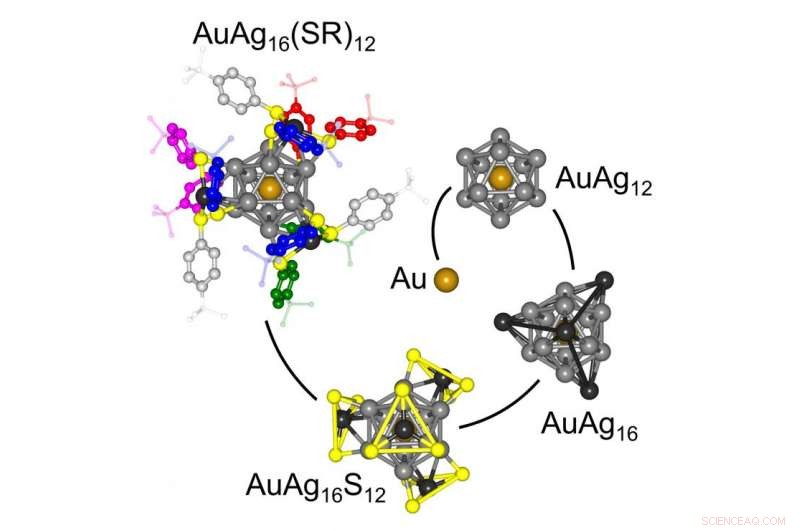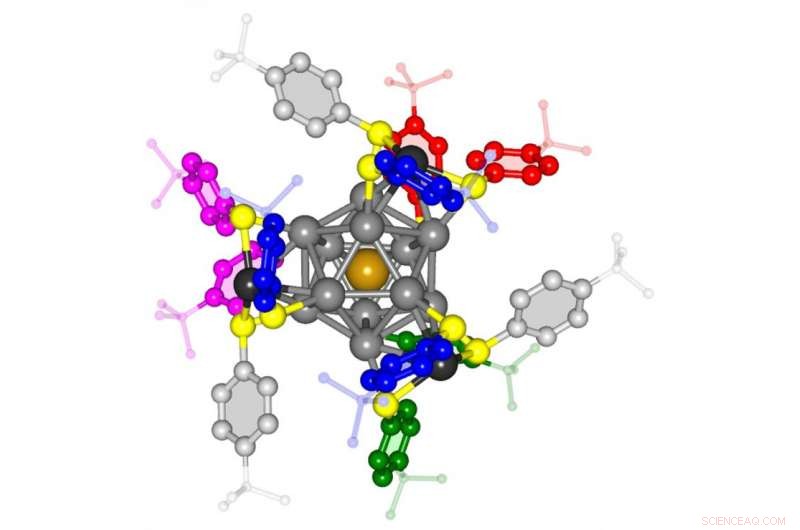
Strukturutvecklingsspiral för AuAg 16 (SR) 12 klunga. Uppbyggnaden av strukturen hos det organiska monolager-kapslade metalliska AuAg 16 kluster visas med start från den centrala enda guldatomen i mitten och dess inkapsling av 12 silveratomer (grå) i en AuAg 12 icosahedron. Lock av AuAg 12 kärna genom förankring av organiska bensenhaltiga molekyler via svavelhaltiga fästen (AuAg 16 S 12 ) kulminerar i bildandet av det monolagerkapslade klustret AuAg 16 (SR) 12 , med de aromatiska ringarna i det täckande monoskiktet som uppvisar unika dimer- och trimerbundna strukturer. Kredit:Georgia Tech / UT
Ett kombinerat teoretiskt och experimentellt tillvägagångssätt har gjort det möjligt för forskare att förutsäga och verifiera hela strukturen hos en monolagerbelagd molekylär metallnanopartikel. Metodiken testades på silvertiolat nanopartiklar, utvidga tidigare kunskaper om guldnanopartiklar, och förväntas vara tillämpbar på ett brett spektrum av storlekar av nanopartiklar gjorda av olika grundämnen.
I en tidning som publicerades i fredags, 25 november, 2016, i journalen Vetenskapens framsteg , forskare från Georgia Institute of Technology och University of Toledo rapporterar om en röntgenbestämd struktur som autentiserar a priori-förutsägelsen, och i samband med första principernas teoretiska analys, stöder den underliggande prognosmetoden.
"Metalnanopartiklar täckta av organiska ligander har grundläggande och tillämpad betydelse för att förstå de fysikaliska och kemiska principerna som styr sammansättningen och atomorganisationen i nanokristallina material, och deras potentiella användning i fält som kvantprickar, sensorer, nanokatalysatorer, biomedicinsk bildbehandling, nanokristallina supergitter och plasmonik, "sa Uzi Landman, Regents professor och F.E. Callaway-ordförande vid Georgia Tech School of Physics. "Vi har varit engagerade i undersökningar av principerna bakom strukturerna hos atomära och molekylära nanokluster, med några av våra tidigare förutsägelser som gjordes för över två decennier sedan, och sålunda, på något vis, den prestation som visas i detta dokument sluter en cirkel för oss, pekar på vägen mot framtida vetenskap som styr atomärt exakta strukturer i denna skala."
Forskningen stöddes av National Science Foundation, flygvapnets kontor för vetenskaplig forskning, och US Department of Energy's Office of Basic Energy Sciences. Beräkningsforskning utfördes vid Georgia Tech Center for Computational Materials Science.
Sedan 1990-talet, forskare har undersökt de unika egenskaperna hos metalliska nanopartiklar vars ytor har passiverats med hjälp av, huvudsakligen, svavelbaserade organiska material. Dessa tiolförsedda strukturer, består av dussintals till hundratals atomer, har unika optiska och elektriska egenskaper beroende på metallernas kemiska identiteter, antalet metallatomer i nanopartikelkärnan, och typen och antalet täckande organiska ligander – som alla bestämmer nanopartikelns struktur.
Att förutsäga strukturen hos sådana nanopartiklar är ett formidabelt teoretiskt mål, och en experimentell utmaning. Nanopartiklar gjorda av olika metaller – guld, silver, platina, koppar, och deras legeringar – kan formas med storlekar från dussintals upp till hundratals atomer, kännetecknas av metallspecifika diskreta sekvenser av antal atomer som reflekterar preferensstabilitet och högre förekomster av nanopartiklar av specifika storlekar. De atomära beståndsdelarna i sådana stabila nanopartiklar är organiserade i strukturer som skiljer sig från motsvarande bulkatomära arrangemang av de ingående metallerna. Den uppsjö av olika strukturer som sålunda bildas står för variationen och mångfalden i de fysikaliska och kemiska egenskaperna hos sådana nanomaterial av ändlig storlek. Dessutom, metallnanopartiklarna är täckta av svavelhaltiga ligander, vars bindning till metallbeståndsdelarna ytterligare komplicerar de strukturella förutsägelserna, Landman noterade.
"Det finns ofta något som ligger till grund för överflöd och atomorganisation i sådana partiklar som är subtilt och ovanligt, ", sade Landman. "Interaktionerna varierar baserat på konkurrerande effekter. Vi lärde oss hur komplicerade effekterna av ligandbindningen kan vara, och hur man integrerar denna kunskap i en strategi för strukturprognoser."

The de novo-predicted and X-ray-confirmed structure of the organic thiol-capped AuAg 16 (SR) 12 cluster. The cluster is comprised of a central icosahedral (AuAg 12 , made of a gold atom surrounded by twelve silver atoms), capped by four AgS 3 mounts, each made of a triangle of sulfur atoms, in yellow, bonded to an anchoring silver atom (black). Each of the twelve sulfur atoms is bonded to an aromatic phenyl ring which is crowned by a tetrabutyl group C(CH 3 ) 3 . Most of the aromatic rings are organized in dimer bundles (ring dimers pink, red and green) and a cyclic trimer (blue rings), with the rest three rings remaining unbundled (light gray). Credit:Georgia Institute of Technology
Using concepts from nucleation theory and judiciously chosen trial structural motifs, taken in part from earlier studies, in conjunction with first-principles quantum-mechanical structure-optimization computational techniques, the researchers advanced in an earlier study (published in 2015 in the Journal of the American Chemical Society ) a de novo predicted structure for the capped silver nanoparticle. This prediction was largely borne out by the subsequent experimentally determined structure accomplished by a group of researchers headed by Professor Terry Bigioni from the department of Chemistry at the University of Toledo.
I den Vetenskapens framsteg papper, the researchers present an experimental X-ray total structure determination and theoretical optimization and analysis of the atomic arrangement in the nanoparticle whose chemical formula is (TOA) 3 AuAg 16 (TBBT) 12 , where TBBT (4-tert-butylbenzenethiol) denotes the organic thiol ligand molecules, and TOA (tetraoctylammonium) serves as a counterion. The inner part of the nanoparticle consists of a central gold atom surrounded by twelve silver atoms, forming a 13-atom five-fold-symmetric icosahedral metal core. The organic ligands have been predicted, and experimentally confirmed, to be anchored to the metal core though bonding to additional four silver atoms, forming four-Ag (TBBT) 3 capping mounts.
Along with the emergence of the novel mount-motif family for silver-thiolate nanoparticles, the study compares in detail the observed and predicted structural, electronic and spectral properties of the monolayer-protected gold-atom-doped silver nanoparticle, largely confirms the de novo structure prediction as well as identifies accessible rotational isomeric ligand-shell conformations, validates the structure forecasting methodology, and provides impetus for further experimental and theoretical developments.
Among the highlights of the reported research was the growing cognition concerning the possible role of the organic ligands in controlling the structure of the nanoparticle.
"If you modify the capping agent, you may modify structures, and that is a radical paradigm change, " Landman said. "Usually, you would expect the metal nanoparticles to arrange in ways dictated by their intermetallic interactions, with only mild influence from the capping organic molecules."
Another highlight pertains to ordering within the ligand shell, which was theoretically predicted 20 years ago in the context of investigations of capped gold nanoparticles, known as "ligand bundling." Subsequently, such ligand orderings have been confirmed in various instances. The identification of intermolecular ligand bundling in the present work, with the emergence of perennial noncovalent phenyl-ring assemblies in the form of a cyclic trimer and T-shape-like dimers, is of relevance to molecular recognition, self-assembled supramolecular architecture, crystal packing, biomolecule (DNA and protein) structures, and quantum-chemistry benchmark studies.
"These findings demonstrate key principles underlying ligand-shell anchoring to the metal core, as well as unique T-like benzene-dimer and cyclic-benzene-trimer ligand bundling configurations, opening vistas for rational design of metal and alloy nanoparticles, " the authors said in the paper. The study "provides an impetus and guidance for continued efforts toward formulation and implementation of structure prediction methodologies for such complex materials systems."
The principles underlying the ligand-shell structure also imply that the structure of bimetallic nanoparticles could be influenced by the coordination of the metal atoms in the ligand shell. Till exempel, if the coordination of the heteroatoms is not compatible with the ligand shell structure, then those heteroatoms will be located in the metal core. Verkligen, heteroatom substitution can be used in this sense as a structural probe. If the incompatible metal atoms are located in the ligand shell, dock, then the structure of the nanoparticle will not be conserved, due to structural changes in the ligand shell necessitated by the different heteroatom bonding requirements.